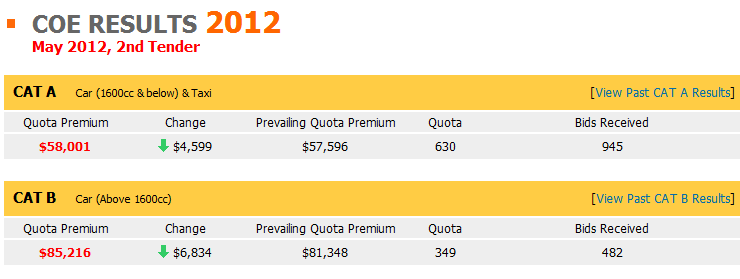No Parking
Singapore is a roughly 275 square mile island city-state located off the southern tip of the Malay Peninsula. With over five million people living on the relatively tiny dot of land, Singapore is the third most densely populated nation in the world, behind Macau and Monaco. With most of the population living in an urban setting, the country has an understandable desire to limit the amount of automobile traffic. Its solution?
Require you to buy a limited-issue license to own a car.
Not drive — own. Yes, one needs a driver’s license to operate the vehicle, but uniquely to Singapore, one can’t simply purchase a car there. First, you need to buy a Certificate of Entitlement (COE) — a ten-year car ownership license which is auctioned off twice a month. There are only a limited number of COEs available in order to control the number of cars (and trucks and motorcycles) on the road, so the price of the certificates fluctuates with demand. As seen below (larger version here), in a May 2012 auction, only about 1,000 total licenses were available for cars with nearly twice as many available for smaller cars than larger ones.

Recent COEs have sold for $45,250 for smaller cars — typically coupes — and $66,500 for larger ones (both in United States dollars). Again, that is in addition to the price of the car itself. And to add further pocketbook woes to the would-be Singaporean driver, cars are typically more expensive in Singapore than they are in the U.S., even before accounting for the COE. For example, a low-end Honda Civic costs about $100,000 (U.S.) on Singapore car site SGCarMart.com (as of May 23, 2012; see the most recent auction results here). An equivalent car on the U.S. site Cars.com runs about a quarter of that. So it should be unsurprising that only about 1,400 bids were placed for car COEs in the auction cited above.
The COEs last a decade but can be renewed by paying the “prevailing quota premium” — the average amount the COEs went for at auction over the past three months. Unrenewed COEs are put back into the auction; cars bought under now-expired COEs must be scrapped or exported out of the country. Because of this, Singapore happens to be the second largest exporter of used cars (after Japan).
The cost of car ownership is extreme, but it is not a major drag on Singapore’s economy. Singapore’s per capita GDP (based on purchasing power parity) consistently ranks in the top five globally. Public transportation is a major part of the country’s economic backbone — average daily ridership of Singapore Mass Rapid Transit (the railway system) is about 2.4 million, totalling nearly half the country’s population. Include bus riders, and that number balloons to about 3.4 million riders daily — or nearly 70% of the nation.
Bonus fact: While Singapore is an English-speaking nation (it is one of four official languages), a significant portion of the population speaks a dialect called “Singlish” — a localized version which is often incomprehensible to non-Singaporeans. In 1999, Goh Chok Tong, then Singapore’s Prime Minister, started the “Speak Good English Movement” in an effort to get Singlish speakers to adopt standard English grammatical rules and usage. The government program, described in depth here, has annual campaigns to improve English usage. The current campaign, titled “How You Speak Makes a Difference,” focuses on the effects of standard English versus Singlish on young children.
From the Archives: The Chief’s Fleet: If the U.S. has anything close to the Singapore COE scheme, it’s the New York City taxi medallion system.
Related: “An Essential Guide to Singlish.” One review, four stars. The cover art shows a person speaking in Singlish, and parsing what he’s saying is on the difficult side of things.

Leave a comment